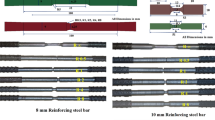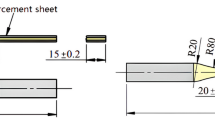Abstract
Structural elements combining Ultra-High Performance Fiber Reinforced Concretes (UHPFRC) and concrete offer a high potential in view of rehabilitation and modification of existing structures. The investigation of the time-dependent behavior of composite “UHPFRC-concrete” elements is a fundamental step in the determination of durability and serviceability. For this, an experimental program was conducted on large composite “UHPFRC-concrete” beams and a numerical model was validated with the test results. The experimental results and a parametric study performed with the numerical model showed that UHPFRC and normal strength reinforced concrete are compatible in the long-term and that the critical period of composite “UHPFRC-concrete” elements are the first 90 days after the casting of the UHPFRC layer. Thus, the high potential of such composite elements can be exploited also in the long term.
Similar content being viewed by others
References
Rossi P (September, 2000) Ultra-high performance fiber reinforced concretes (UHPFRC): an overview. In BEFIB'2000', RILEM Symposium on Fiber-Reinforced Concretes (FRC). Lyon, France, pp. 87–100.
Habel K (2004) Structural behaviour of elements combining ultra-high performance fibre reinforced concretes (UHPFRC) and reinforced concrete. Doctoral thesis, No. 3036, EPFL, Lausanne, Switzerland, (http://ahdoc.epfl.ch/EPFL/theses/2004/3036/EPFL_TH3036.pdf).
Parant E (2003) Mécanismes d'endommagement et comportements mécaniques d'un composite cimentaire fibré multi-échelles sous sollicitations sévères: fatigue, choc, corrosion. Doctoral thesis, LCPC, France, December.
Charron J-P, Denarié E, Brühwiler E (2004) Permeability of UHPFRC under high stresses. In: Advances in Concrete Through Science and Engineering. RILEM Symposium, March 22–24, Evanston, USA, CD-ROM.
Roux N, Andrade C, Sanjuan MA (1996) Experimental study of durability of reactive powder concretes. ASCE Journal of Materials in Civil Engineering 8(1):1–6.
Li V (2003) On engineered cementitious composites (ECC)–-A review of the material and its applications. Journal of Advanced Concrete Technology 1(3):215–230.
Cheyrezy M, Behloul M (August, 2001) Creep and shrinkage of ultra-high performance concrete. In: Creep, Shrinkage and Durability Mechanics of Concrete and other Quasi-Brittle Materials (Concreep 6). Boston, USA, pp. 527–538.
Morin V, Cohen-Tenoudji F, Feylessoufi A, Richard P (2002) Evolution of the capillary network in a reactive powder concrete during hydration process. Cement and Concrete Research 32(12):1907–1914.
Schachinger I, Schmidt K, Heinz D (2003) Zeitabhängiges Verformungsverhalten von UHFB. (Time-dependent deformational behavior of Ultra-High Strength Concrete), In: Ultrahochfester Beton, Innovationen im Bauwesen–-Beiträge aus Praxis und Wissenschaft Bauwerk, Berlin, Leipzig, Germany, 67–77 (in German).
Association Française du Génie Civil (2002) Bétons fibrés à ultra-hautes performances. (SETRA–-Service d'études techniques des routes et autoroutes, AFGC, France, January.
Denarié E, Habel K, Brühwiler E (June, 2003) Structural behavior of hybrid elements with Advanced Cementitious Materials (HPFRCC). In: High Performance Fiber Reinforced Cement Composites (HPFRCC-4) RILEM Proceedings PRO 30, Ann Arbor, USA, 301–312.
Alaee FJ, Karihaloo B (2003) Retrofitting of reinforced concrete beams with CARDIFRC. ASCE Journal of Composites for Construction 7(3):174–186.
Bernard O (2000) Comportement à long terme des éléments de structure formés de bétons d'âges différents. Doctoral Thesis, No. 2283, EPFL, Lausanne, Switzerland.
Bernard O, Brühwiler E (2002) Influence of autogenous shrinkage on early age behaviour of structural elements consisting of concretes of different ages. Materials and Structures 35(235):550–556.
Rossi P (September, 2002) Development of new cement composite material for construction. In: Innovations and Developments in Concrete Materials and Construction. Proceedings of the International Conference, Dundee, Scotland, pp. 17–29.
Silfwerbrand J (1997) Stresses and strains in composite concrete beams subjected to differential shrinkage. ACI Structural Journal 94(4): 347–353.
Roelfstra PE (1989) A numerical approach to investigate the properties of concrete–-numerical concrete. Doctoral Thesis, No. 788, EPFL, Lausanne, Switzerland.
Finite Element Modules for Materials Science and Structural Engineering, website, Retrieved: August 20, 2004, from http://www.femmasse.com.
De Schutter G, Taerwe L (1996) Degree of hydration-based description of mechanical properties of early age concrete. Materials and Structures 29(190):335–344.
CEB (July, 1991) CEB-FIP Model Code 1990. CEB, Bulletin d'Information 204, Lausanne, Switzerland.
Author information
Authors and Affiliations
Rights and permissions
About this article
Cite this article
Habel, K., Denarié, E. & Brühwiler, E. Time dependent behavior of elements combining ultra-high performance fiber reinforced concretes (UHPFRC) and reinforced concrete. Mater Struct 39, 557–569 (2006). https://doi.org/10.1007/s11527-005-9045-0
Received:
Accepted:
Published:
Issue Date:
DOI: https://doi.org/10.1007/s11527-005-9045-0




